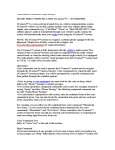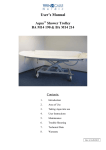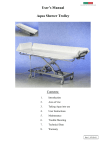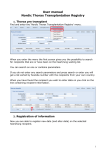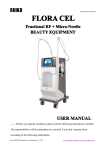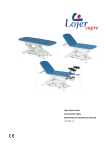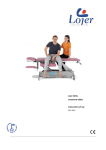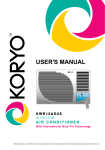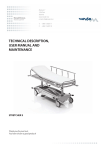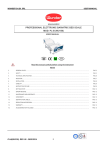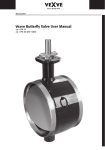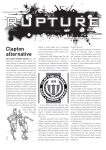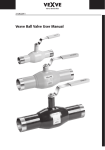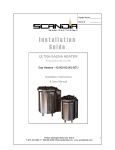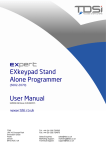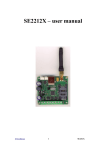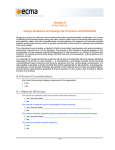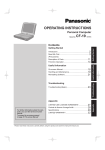Download Lojer.com Userdata Lojer User Manuals Healthcare R8009
Transcript
Lojer SCANDIATM SC330 SC330 Operating Table User manual R8009 (17.05.2012) Table of Contents 1 Lojer Scandia SC330 Operating Table ................................................................ ............................................................................ ............................................ 4 2 Operating table parts ................................................................ ................................................................................................ ....................................................................... ....................................... 4 3 2.1 Options ............................................................................................................................. 5 2.2 Hand control .................................................................................................................... 5 2.3 BluetoothTM hand control ( ) ...................................................................................... 7 Safety instructions ................................................................ ................................................................................................ ............................................................................ ............................................ 8 3.1 4 Before first time use ................................................................ ................................................................................................ ......................................................................... ......................................... 9 4.1 5 Precautions..................................................................................................................... 10 Hand control functions ................................................................ ................................................................................................ .................................................................. .................................. 10 5.1 Power ON/StandBy ....................................................................................................... 11 5.2 LED lights and audible signals .................................................................................... 11 5.3 Lock.................................................................................................................................. 12 5.4 Unlock ............................................................................................................................. 12 5.5 Patient orientation ........................................................................................................ 12 5.6 Height .............................................................................................................................. 13 5.7 Incline back section...................................................................................................... 13 5.8 Incline leg section......................................................................................................... 13 5.9 Lateral tilt ........................................................................................................................ 13 5.10 Trendelenburg and anti-Trendelenburg .............................................................. 13 5.11 Zero-position ............................................................................................................. 14 5.12 Slide ( ) ...................................................................................................................... 14 5.13 Moving the operating table ..................................................................................... 14 5.13.1 Locking the direction with the directional wheel ( ).................................... 15 5.13.2 Driving forward and backward ( ) .................................................................... 15 5.14 6 Warning signs .................................................................................................................. 8 Using the foot switch (accessory) .......................................................................... 16 Adjusting the head section ................................................................ ............................................................................................ ............................................................ 17 6.1 Angle of inclination adjustment for head section .................................................. 18 6.2 Vertical adjustment of head section ......................................................................... 18 7 Attaching operating table sections ................................................................ ............................................................................... ............................................... 18 8 Removing operating table sections ................................................................ .............................................................................. .............................................. 19 Copyright © Lojer Oy, 2012 version 1.11 2 9 Charging the battery ................................................................ ................................................................................................ ....................................................................... ....................................... 19 10 Table top configurations ................................................................ ................................................................................................ ................................................................ 20 10.1 Standard configurations .......................................................................................... 20 10.2 Safe working load 350 kg ......................................................................................... 21 10.3 Lithotomy configuration, step 1 ............................................................................. 21 10.4 Lithotomy configuration, step 2 ............................................................................. 22 10.5 Cardiovascular configuration ................................................................................. 22 10.6 TUR Configuration .................................................................................................... 22 10.7 Prohibited configurations........................................................................................ 23 11 Limitations in movements ................................................................ ............................................................................................. ............................................................. 23 12 Cleaning and disinfection ................................................................ .............................................................................................. .............................................................. 25 12.1 Metal and plastic surfaces ....................................................................................... 25 12.2 Operating table mattresses and straps ................................................................. 25 13 Maintenance ................................................................ ................................................................................................ .................................................................................... .................................................... 26 13.1 Monthly tasks ............................................................................................................. 26 13.2 Annual tasks ............................................................................................................... 26 14 Troubleshooting................................................................ ................................................................................................ .............................................................................. .............................................. 26 15 Technical data ................................................................ ................................................................................................ .................................................................................. .................................................. 29 15.1 Identification plate .................................................................................................... 30 15.2 Symbols ....................................................................................................................... 31 15.3 Recycling ..................................................................................................................... 31 15.4 Standards .................................................................................................................... 32 16 Warranty ................................................................ ................................................................................................ ........................................................................................... ........................................................... 32 17 Contact information ................................................................ ................................................................................................ ....................................................................... ....................................... 34 For easy access, The user manual should always be kept close to the operating table. Copyright © Lojer Oy, 2012 version 1.11 3 1 Lojer Scandia SC330 Operating Table This document gives instructions on how to use the Scandia SC330 Operating Table with software version 3.0 or later. The Scandia SC330 Operating Table is designed to be used for human surgery in operating rooms. The battery-operated operating table consists of reconfigurable table sections that can be adjusted according to what is required in an operation. The operating table has various hydraulic adjustment functions for the entire table top as well as for back and leg sections. The hydraulic functions are operated by either a cable-connected or a wireless hand control. For correct and safe use of the table, read all instructions carefully before starting to use the operating table. Ensure that all operating persons are familiar with these instructions IMPORTANT 2 Operating table parts 4 3 2 3 2 1 5 8 7 6 9 11 12 1 2 3 4 5-6 7 8 9 10 11 12 10 Head section 40 cm section 25 cm section Center section Hand control Locking latch Accessory rail Floor lock Main connection panel Potential equalization conductor Connection for optional foot switch Figure 1. Scandia SC330 Operating Table Copyright © Lojer Oy, 2012 version 1.11 4 1 2 3 4 5 6 Auxiliary hand control Computer interface , D-connector D Charging indicator LED (green) Standby switch (Table On/StandBy) Fuse (3) Charging socket Figure 2. Main connection panel 2.1 Options You can order the operating table with the following options: Bluetooth hand control co (see chapter 2.3) Sliding top function (see chapter 5.12) Directional wheel (see chapter 5.13) Driving wheel unit (see chapter 5.13) NOTE! The options are marked with in this manual. 2.2 Hand control The operating table movements can be controlled by either of the two hand controls. The standard hand control (grey covers) is used with a cable connection. It is connected to the socket in the column of the operating table. The auxiliary hand control (grey ( covers) can be used with a cable connection, connection or wirelessly if the table is equipped with optional BluetoothTM hand control (blue covers). Both hand controls have the same functions and symbols. They operate in parallel, for example, when pressing a button in one hand control the corresponding LED indicator illuminates uminates in the other hand control. However, you can only operate only one hand control at a time. It is not possible to select functions from both hand controls simultaneously. Copyright © Lojer Oy, 2012 version 1.11 5 Both hand controls revert into power saving mode if not used for 1-240 min (adjustable time with service software). 23 22 24 19 18 21 15 13 20 12 17 10 16 8 14 11 7 9 4 6 2 3 1 1 2 3 4 5 6 7 8 9 10 11 12 13 14 15 16 17 18 19 20 21 22 23 24 5 Power ON/StandBy Battery full (green LED) Charging batteries, line power ON (yellow LED) Battery low (red LED) BluetoothTM wireless connection (blue LED) Floor locks locked (green LED) Floor locks unlocked (yellow LED) Normal patient orientation Reverse patient orientation Slide forward ( optional) Slide backward ( optional) Zero-position (initial position of the operating table) Lateral tilt, patient’s right Lateral tilt, patient’s left Table top up Table top down Incline leg section downwards Incline leg section upwards Incline back section downwards Incline back section upwards Anti-Trendelenburg Trendelenburg Drive forward or Directional wheel activation ( optional) Drive backward or Directional wheel activation ( optional) Figure 3. Hand controller Copyright © Lojer Oy, 2012 version 1.11 6 2.3 BluetoothTM hand control ( ) The auxiliary BluetoothTM hand control is located under the hatch in the main connection panel. It is normally connected to the operating table with a cable. BluetoothTM hand control has a built-in battery that is charged automatically when the auxiliary hand control is connected to the operating table with a cable either in the charging socket of the main connection panel (Fig. 2) or to the socket in the column of the operating table. NOTE! The battery of the BluetoothTM hand controller can only be charged when the Standby switch is turned ON. The yellow LED illuminates when charging is in progress (see point 3 in Fig. 3) The auxiliary hand controller is initially paired and only meant for use with the specific table and will not operate together with any other equipment. To ensure this, the table and hand controller are paired together: attach Bluetooth hand control in the cable, turn On/StandBy to Standby and then back On. Then wait for 5 seconds until you see LED signal. Hand control is now ready for wireless use with the specific table. To activate the BluetoothTM wireless function, first disconnect the cable from the handset then hold down the power ON button for a few seconds. The blue LED starts to flash and is lit when the wireless function is activated. Hand control turns off, if the connection is not established in 8 seconds. The operating range for the wireless connection is 5-10 meters in an open space. Bluetooth hand control revert into power saving mode if not used for 30 minutes. If the wireless BluetoothTM connection between the hand set and table can’t be established the hand set will power down. You can reactivate it by pressing the Power button. Figure 4. IMPORTANT Auxiliary hand control in the main connection panel When placing the hand control in the service hatch, make sure the cable is not touching the controller buttons. Copyright © Lojer Oy, 2012 version 1.11 7 3 Safety instructions IMPORTANT Ensure that Scandia SC330 operating table is not exposed to electromagnetic radiation exceeding applicable norms. Portable and mobile RF communications equipment can affect the operating table. IMPORTANT Use antistatic cushions to ensure discharge of static electric. IMPORTANT IMPORTANT Use grounding cord during all functions to prevent possible electrostatic discharge. IMPORTANT Although mechanically possible, do not use the operating table in other configurations than those illustrated in this document. See Section 10 Table top configurations. IMPORTANT Check that the table sections are correctly locked in place before using the table. See Section 7 Attaching operating table sections. IMPORTANT When not in use, ensure that the hand control is secured safely to the head section of the table. This will prevent it from getting caught between different sections or moving parts of the operating table as well as other equipment. IMPORTANT Make sure before using the adjustment functions that there are no body parts of the patient or personnel between different sections or moving parts of the operating table. IMPORTANT Pay extra attention to any table top movements downwards, especially when the column in its lower position. IMPORTANT In case of a malfunction, take the operating table immediately out of use and contact the authorized service personnel. 3.1 Warning signs Pay attention to the following warning signs attached to the base of the operating table. Copyright © Lojer Oy, 2012 version 1.11 8 1 Safe working load 350 kg only in pre-defined configuration (see 10.2) 2 Safe working load 280 kg in normal position on floor locks, 200 kg with sliding top out 3 Safe working load 250 kg in reverse position, also with sliding top out 4 Safe working load 250 kg on wheels 5 The max load of accessories is 40 kg, and load per one accessory rail max is 25 kg. Figure 5. IMPORTANT 4 Maximum load Safe working load (SWL) is the maximum allowed load including the patient, mattresses and accessories. Overloading may result in tipping of the table. Before first time use IMPORTANT Use the operating table in temperature of +10° C to +40 °C and humidity of 30 % to 75 %. IMPORTANT Let the operating table rest in room temperature for six hours before taking it into use. Attach the potential equalization conductor to the socket in the operating table base. 1. Open the main connection panel hatch and insert the fuse (20A) to the socket located in the panel. The fuse is supplied in a separate box together with the hand controls and cables. 2. In the main connection panel, turn the standby switch to the ON position. NOTE! Turn the standby switch to “StandBy” during cleaning, maintenance or in case of emergency. 3. Connect the main supply cable to the socket in the main connection panel and charge the operating table batteries for 10-20 hours before using the table. 4. Connect the spiral cable to the grey hand control and to the socket in the column of the operating table (figure 6). Ensure that the connector is attached in the right way (pins match the holes) and then secure into position by tightening the nut. Similarly, connect the blue auxilary hand control to the cable socket in the connection panel (see figure 4). Copyright © Lojer Oy, 2012 version 1.11 9 Figure 6. Socket for the hand control cable is located under the center section 5. Test the operating table functions with the hand control. 6. Check that all castors run and freely and that they rotate freely allowing movement of the table in any direction°. 7. Test that the accessories of the table work correctly. For instructions on how to install and use the accessories, refer to the manufacturers’ documentation. Make sure that they do not endanger the safety of the operating table. 4.1 Precautions 5 IMPORTANT Always immobilize the operating table by pressing the Lock button before using the adjustment functions. IMPORTANT Make sure that there is enough room around, below and above the operating table to complete all functions, especially when accessories are attached. Hand control functions You can press only one button at a time. If you press more than one button at the same time, neither will work. If you press a second button while one function is operating, the first function will then be stopped. Each movement has a software-controlled limit. You can stop any motion by releasing the function button or you can hold the button until it reaches the limit set for that function, and the movement will stop automatically. NOTE! Even when the Power LED of the hand control is off, the table uses a small amount of power. This may lead to full discharge of the batteries after some weeks. Copyright © Lojer Oy, 2012 version 1.11 10 5.1 Power ON/StandBy Press the ON/StandBy button in the hand control to activate the operating table. During start-up phase, three LEDs are flashing as a string, and all functions are disabled. Green LEDs illuminate beside the ON/StandBy button as well as in the Lock and the Patient orientation buttons. NOTE! The system switches off power if you do not use any function for 1-240 minutes (time adjustable). Reactivate the operating table by pressing ON button in either of the hand controls. Turn off power by pressing the ON/StandBy button in the hand control. IMPORTANT Turning off power using the ON/StandBy ON/StandBy button stops all movements of the table. You can press it also in case you need to stop a function quickly. 5.2 LED lights and audible signals The battery indicator LEDs are located at the bottom of the hand control, beside the ON/StandBy button (see Figure 3 Hand control). Table 1. Battery indicator LEDs Colour Light Explanation Green Continuous Battery has sufficient charge for use Slow flashing Dropped battery capacity, sufficient to carry out the ongoing operation. Yellow Continuous Battery charging ongoing. Red Continuous Battery capacity below critical level. Charge the battery immediately. The following indicators relate to the function buttons of the hand control. Table 2. Function button LEDs and audible signals Signal Explanation Changing green/yellow LEDs (lock function) The table is being locked/unlocked. Please wait until flashing stops and either of the LEDs is lit continuously. Blue LED (BluetoothTM) The wireless connection between the hand control and the table is established. Copyright © Lojer Oy, 2012 version 1.11 11 Signal Explanation Yellow (Unlock) LED is continuously lit and green (Lock) LED flashes every two seconds. Either the directional wheel or driving wheel is activated (both options) All three power indicator LEDs are flashing. Repeating beep sound during movements. Internal problem, contact service for troubleshooting. Short beep Indicates that you should pay attention with the table movements, or the adjustment function has reached the endpoint, for example, the leg section has reached the max angle or table is locked/unlocked. Double beep Safety stop of all movements. Communication problem between hand control and table CPU. Contact service for troubleshooting. 5.3 Lock To immobilize the operating table, press the Lock button. The operating table floor locks come down. The green/yellow LEDs in the Lock and Unlock buttons start to flash and you can hear and audible short beep. When the green LED in the Lock button is lit continuously the operating table is completely immobilized. NOTE! Do not turn off power while immobilizing is in progress. NOTE! To ensure safety, only table height adjustment and trendelenburg functions operate when the table is unlocked. 5.4 Unlock By pressing the Unlock button in the hand control for 1 second, the floor locks are disengaged and lift up. The green/yellow LEDs in the Lock Lock and Unlock buttons start to flash and you can hear a short audible beep. The operating table is now on the castors. You can move the operating table when the yellow LED beside the Unlock button is lit continuously. NOTE! Do not turn off power while mobilizing is in progress. 5.5 Patient orientation In the normal patient orientation the patient’s head is positioned towards the longer end of the operating table base (viewed side on), and in the reverse patient orientation, orientation towards the shorter end of the operating table base. The green LED indicates the orientation in the hand control; on the right for normal and on the left for reverse patient orientation. Copyright © Lojer Oy, 2012 version 1.11 12 You can change the orientation into reverse by pressing and holding for 3 seconds the Reverse patient orientation orientation button on the left. To change the orientation into normal patient orientation press and hold for 3 seconds the Normal patient orientation button on the right. The green LED is lit continuously when the orientation has been changed. The table will remain in the selected orientation even after switching off power from the ON/StandBy button. NOTE! For safety reasons, the button must be pressed for 3 seconds to activate. NOTE! The hand control and buttons function the same way, whichever patient orientation (Normal or Reverse) is selected. 5.6 Height Adjust the height of the table top level by pressing Table up and Table down buttons. 5.7 Incline back section Adjust the inclination of the entire back section by pressing the Incline back section downwards and Incline back section section upwards buttons. The maximum inclination upwards is 70°, and downwards 30°. 5.8 Incline leg section Adjust the inclination of the entire leg section by pressing the Incline leg eg section upwards and Incline leg section downwards buttons. The maximum inclination of the leg section both upwards and downwards is 90°. 5.9 Lateral tilt Tilt the entire table level to the right, viewed from the head end, by pressing the Tilt right button. Tilt the table level to the left by pressing the Tilt left button. The maximum tilt to both sides is 17°. 5.10 Trendelenburg and antianti-Trendelenburg Incline the entire tabletop level towards the head end to the Trendelenburgposition by pressing the Trendelenburg button and to the anti-Trendelenburgposition by pressing the AntiAnti-Trendelenburg Trendelenburg button. The maximum inclination to both positions is 30°. Return the tabletop back to the horizontal position by pressing the ZeroZero-position button or AntiAnti-Trendelenburg button for Trendelenburg-position and vice versa. NOTE! The Trendelenburg button inclines always the head end, also when the orientation is reversed. Copyright © Lojer Oy, 2012 version 1.11 13 5.11 ZeroZero-position To return the table back to its initial position, press the ZeroZero-position button. This function returns the slide of the table top, lateral tilt, trendelenburg and antitrendelenburg positions, and the inclinations of the leg and back sections one by one to the initial position. Foot and back sections and trendelenburg are driven in 15° steps. The height is adjusted separately from the hand control. You will hear an audible beep when the operating table has reached the zeroposition within 1-2° tolerance. Each movement has an individual zero -position function for lateral tilt, trendelenburg, back section and leg section. When any of the movements reach the horizontal level, the movement is stopped. To continue the movements, briefly release the button, press it again and the function will allow further adjustment. NOTE! If all sections are not straight and leveled after reaching the zero-position, the safety sensors of the operating table must be recalibrated. Contact the authorized service personnel for recalibration. 5.12 Slide ( ) Slide the operating table top in the direction of the standard head end by pressing the right arrow of the Slide button continuously until the table reaches the required position. Similarly, to slide the table top in the direction of the standard foot end press the left arrow. arrow The maximum slide movement is 300 mm. IMPORTANT When using the slide, the safe working load is 200 kg in normal orientation and 250 in reverse position. NOTE! For safety reasons, some functions do not operate when using the slide function. For details, see Section 11. NOTE! Limitations in movements. NOTE! The direction of the slide function will not change in the Reverse Patient orientation. The slide moves always towards the standard head end. 5.13 Moving the operating table The operating table may be equipped with an optional directional wheel function, or an optional motor-operated driving wheel. Both functions lock the direction of the operating table to ease transporting along corridors. IMPORTANT When on castors, the safe working load for is 250 kg. For maximum stability, the table must be lowered below 800mm before patient transfer. Copyright © Lojer Oy, 2012 version 1.11 14 IMPORTANT Do not use the operating table for transporting the patient if the floor is uneven. Max floor angle is ± 2 degrees. NOTE! For safety reasons, the drive function and the directional wheel do not function in wireless mode. Use always a hand control attached by cable. Before moving the operating table, 1. Be sure that the patient is properly secured to the table. 2. Center the patient over the main lift column of the operating table. 3. Lower the table top below 800 mm height. 4. Remove all cables from the table. Check the floor for and remove objects that may interfere with moving the table, such as power cords or table accessories. 5. Have at least one person at each end of the table. 5.13.1 Locking the direction with the directional wheel ( ) NOTE! The driving wheel replaces the function of the direction lock castor. NOTE! The different table top functions will not work when the directional wheel is activated. 1. Press either of the arrow buttons at the top of the hand control for few seconds to activate the directional wheel. The Unlock LED is continuously lit and Lock LED flashes every two seconds when the wheel is activated. The directional wheel comes down and you can move the table straight forward and backward manually. When directional wheel is activated, moving the table sideways is difficult and thus not recommended. 2. To deactivate the direction locking, press the Unlock button on the hand control or release the movement button for about 7 seconds. 5.13.2 Driving forward and backward ( ) NOTE! The adjusting functions of the hand control (except up/down and trendelenburg) will not work when the drive function is on. NOTE! The drive function does not work in wireless mode, or if main power cable is attached for battery charging. 1. Go stand at the head end of the operating table. 2. If the operating table is in immobilized position, press the Unlock button. 3. Attach the hand control to the accessory rail on your right hand side (see figure 7). 4. Press shortly either of the arrows at the top of the hand control. You’ll hear a double beeb. In a few seconds the driving wheel comes down and touches the floor. Unlock LED is continuously lit and Lock LED flashes every two seconds when the wheel is activated. Copyright © Lojer Oy, 2012 version 1.11 15 5. Press shortly the arrow pointing forward at the top of the hand control to drive the operating table away from you. Press shortly the arrow pointing backward to drive the operating table to the opposite direction. You will hear a double-beep before the operating table starts to move. The driving wheel has a so called soft start: the operating table moves first slowly and then faster. For adjusting the speed of the driving wheel, contact the authorized service personnel. Figure 7. Driving the operating table 6. To stop the operating table, release the button. The operating table slows down smoothly and stops. To deactivate the drive function, press the Unlock button or release the movement button for about 7 seconds. NOTE! The logic of the arrow buttons is reversed when attaching the hand control to the accessory rail of the head section on your left hand side NOTE! If the power of the table battery falls below the critical level (the red LED above the battery symbol illuminates in the hand control), the system automatically stops the drive function and lifts the driving wheel up. The castors of the operating table operate normally, and you can move the table manually. Recharge the table batteries immediately. NOTE! When using the drive function, the table may also be stopped by pushing the Power ON/StandBy ON/StandBy button (emergency stop). 5.14 Using the foot switch (accessory) The foot switch is an accessory. The footswitch functions include: Trendelenburg and anti-Trendelenburg Left and right lateral tilt Table up and down Copyright © Lojer Oy, 2012 version 1.11 16 1 2 3 Figure 8. Trendelenburg and anti-Trendelenburg anti Lateral tilt Table up and down Footswitch The footswitch enables procedures where the surgeon is normally seated at the short end of the table. It is possible to change the footswitch functions and the pedal positioning with Lojer maintenance software. Contact service for changing the setup. To connect the foot switch remove the connector cover and attach the footswitch connector to the socket at the leg end of the table. Figure 9. 6 Attaching the foot switch Adjusting the head section A B Figure 10. Head section Copyright © Lojer Oy, 2012 version 1.11 17 6.1 Angle of inclination adjustment for head section 1. Push the shackle (A) upwards 2. Set the head section to the desired inclination 3. Release the shackle to lock in place 6.2 Vertical adjustment of head section 4. Turn the locking handle (B) anti-clockwise to release the head plate 5. Move the head plate up or down to the required angle 6. Turn the handle (B) clockwise to lock in place 7. Check the angle of inclination and adjust if necessary, as described in “Adjustment of angle of inclination”, e.g. Set the head plate parallel with the back section. 7 Attaching operating table sections The sections are locked to each other with a simple locking mechanism. 1. Take a firm grip of the section. 2. Align the pins with the holes Figure 11. Attaching the table section 3. Insert the section by pushing evenly so that the pins engage at the same time. 4. To lock the section in place snap the latches on both sides into place If visible red signs are visible the latch is not locked. Figure 12. Latches Copyright © Lojer Oy, 2012 version 1.11 18 5. Check that the section is firmly attached by pulling it. IMPORTANT 8 Open latches indicate that the sections are not fully engaged and may release unintentionally during the operation (patient safety risk). Red marks must NOT be visible. Removing operating table sections 1. On each side, raise the latch (A) until it reaches its upper position. Hold it. 2. Grasp the section to be removed with both hands and pull evenly in the longitudinal direction of the table top. (This task will be easier if the section is raised slightly). A Figure 13. Opening latches NOTE! To ease of section removal, best results are achieved by applying even and gentle pulling force in the longitudinal direction. 9 Charging the battery It is recommended that you charge the battery daily after use. In normal use the battery lasts approximately one week. However, charging of an empty battery can take ten to twenty hours depending on the battery voltage. IMPORTANT IMPORTANT No person is not allowed to lie on the operating table during charging. Be careful not to let any liquid enter the main connection panel. 1. Immobilize the operating table by pressing the Lock button. 2. Open the hatch of the main connection panel at the base of the operating table. Copyright © Lojer Oy, 2012 version 1.11 19 Figure 14. Main connection panel 3. Take the main cable and insert the plug into the charging socket. 4. Connect the other end of the main cable to the wall socket. The green light in the main connection panel and the yellow LED in the hand control should illuminate to indicate battery charging. 5. When the green LED above the battery symbol in the hand control illuminates This indicates the battery is now full. Disconnect the main cable. 6. Close the main connection panel hatch. IMPORTANT! Batteries should be changed every 3 years or when charge/discharge cycle drops below 6-8 hours. 10 Table top configurations You can change the table top configuration according to your needs. The configurations allowed are described in the following sections. NOTE! In the normal configuration without accessories, the system prevents the most typical collisions of operating table parts, provided there are no obstacles above or underneath the table top. 10.1 Standard configurations Figure 15. Standard configuration (head section on normal side) Copyright © Lojer Oy, 2012 version 1.11 20 Figure 16. Reversed configuration (head section on reverse side) 10.2 Safe working load 350 kg Figure 17. Biggest possible load for the table, head section on normal side IMPORTANT! SWL 350 kg is possible only with the table top configuration decribed in Figure 17. Head section is on normal side, and the patient is centered over the column. Table must be locked on floor locks before moving patient on the table, and sliding top must not be used. 10.3 Lithotomy configuration, step 1 Figure 18. Lithotomy configuration, step 1 Copyright © Lojer Oy, 2012 version 1.11 21 10.4 Lithotomy configuration, step 2 Figure 19. Lithotomy configuration, step 2 10.5 Cardiovascular configuration Figure 20. Cardiovascular configuration 10.6 TUR Configuration Figure 21. Configuration for TUR with Extension Plate 60150 Copyright © Lojer Oy, 2012 version 1.11 22 10.7 Prohibited configurations 11 IMPORTANT Using the table in following configurations increase the risk of table instability. With the increased risk of accident or injury to the patient and persons in the vicinity of the equipment, these configurations are considered unstable and are therefore prohibited. Figure 22. Prohibited configurations, example 1 (head section on reverse side). Figure 23. Prohibited configurations, example 2 (head section on normal side) Limitations in movements The operating table system software controls certain functions and prevents movements beyond the range specified in the following table. You cannot override the limits with the hand control. IMPORTANT In movements other than specified in the table, and when using the operating table with a non-standard configuration, make sure that the operating table parts do not collide with the floor, walls or other obstacles. Copyright © Lojer Oy, 2012 version 1.11 23 The first row specifies the normal minimum or maximum position of each function. The following rows describe the minimum and maximum positions in special situations. Function Position Situation Table height 650 mm Normal min. height 920 mm Min. height when leg section inclination > 65° downwards -30° Normal max. inclination -15° Max. inclination when lateral tilt >±5° -13° Max. inclination when back section inclination -20° -30° Normal max. inclination -15° Max. inclination when lateral tilt > ±5° -13° Max. inclination when leg section inclination > 55° downwards Disabled Leg section inclination 65°downwards ± 17° Normal max. tilt ± 5° Max. tilt when Trendelenburg or antiTrendelenburg >20° Disabled Leg section inclination > 65° downwards -90° Normal max. inclination downwards -65° Max. inclination when table height < 920 mm 300 mm Normal slide towards the standard head end Disabled Trendelenburg or anti-Trendelenburg > 13° Trendelenburg AntiTrendelenburg Lateral tilt Leg section Sliding top ( ) Leg section inclination > 1°downwards Copyright © Lojer Oy, 2012 version 1.11 24 12 Cleaning and disinfection IMPORTANT Switch power switch to StandBy before cleaning and detach the main power cable. IMPORTANT Do not use shower, high-pressure water guns or similar for cleaning. Under no circumstances should steam or extremely hot water be used to disinfect or clean the table. IMPORTANT Do not clean the operating table in room with high temperature and air humidity. It can cause malfunctions in the hydraulics system. IMPORTANT Do not let fluids in the main connection panel or inner parts of the operating table. IMPORTANT IMPORTANT Do not use solvents for cleaning. Dry all surfaces thoroughly after cleaning or disinfection. 12.1 Metal and plastic surfaces Clean the metal and plastic surfaces and the hand controls with a damp cloth and weak alkaline cleaning fluid. Use small brush for corners and other difficult spots. Rinse with clean water and dry carefully after cleaning. Use disinfectant (e.g. 70% methylated spirit) and follow the disinfectant manufacturer’s instructions for use. Let dry by evaporation in room temperature. NOTE! All surfaces must be dry before switching the operating table ON. 12.2 Operating table mattresses and straps Remove the table top pads before cleaning. Wash mattresses and straps carefully with warm water (50°) and neutral (pH7) detergent. Rinse with clean water, wipe them dry and leave to dry in room temperature. Use small brush for corners and other difficult spots. Spray a disinfectant (70% methylated spirit or 1000-5000 mg/ltr solution of hypochlorite in water) directly onto the pads. Rinse with clean water. Wipe clean with absorbent soft paper and let dry by evaporation in room temperature. If necessary brush the Velcro bands, the pads and the tabletop with a non-metallic brush. NOTE! Do not let hypochlorite solution to come into contact with metallic parts. Long-term contact with mattresses may damage them. NOTE! If non-Lojer pads are used, refer to the table pad manufacturer’s instructions on the use of disinfectants with table pads. Copyright © Lojer Oy, 2012 version 1.11 25 Check mattresses regularly for damages and wearing. Replace mattress with damaged surface with new one immediately. Do not storage mattresses in close distance with sharp edges, and not leave them to high temperate. The mattresses must not be exposed to ozone. 13 Maintenance 13.1 Monthly tasks Carry out the following checks and maintenance tasks once a month. Keep record of the checks and the results. Check all functions and movements of the table top one by one by adjusting them to their end position and back. Remove all sections. Clean all dowels pins, holes and latches. Lubricate them with thin machine or instrument oil. Check that sections lock properly. Check that the castors run freely and turn 360°. Check that the cables and plugs are intact and that the connections function correctly. 13.2 Annual tasks The operating table should be serviced at least once a year by an authorized service person. The annual maintenance is instructed in a separate maintenance manual. 14 Troubleshooting Symptom Failure Action None of the hand control functions operate and no leds are visible. The cable of the standard hand control is not connected. Check the cable connections and that the cable is intact. The battery of the auxiliary (Bluetooth) hand control is empty. Charge the battery by connecting the auxiliary hand control to the operating table with a cable. In the meanwhile, use the standard hand control. Stand-by switch of the table (under the hatch) is turned StandBy Turn the switch ON Copyright © Lojer Oy, 2012 version 1.11 26 Symptom Failure Action The batteries of the operating table are empty. Connect the main cable to the charging socket and charge the batteries. The hand control has damaged. Contact service. In the meanwhile, use the other hand control Bluetooth control cannot be turned on – only leds flash briefly The hand control battery is Connect the cable, turn empty Standby switch to ON and let the battery be charged for 1-2 hours. Foot pedal do not function. Cable is not connected properly. Connect the cable as instructed. Foot pedal functions have not been set up with maintenance software. Contact service to program the functions. The hand control is turned ON, but only up/down and trendelenburg do operate. Table is unlocked. Press table locking button to enable the movements. Drive motor does not function Table is locked. Press table unlocking button to enable the movements. The power cable is attached to the table. Disconnect the power cable. All power indication leds in hand control are flashing simultaneously Table is locked, and you hear beep sounds during table movements. Reset the alarm by setting main switch to Standby and back On. Charging led (yellow) remains On even after power plug has been removed Battery voltage remains high after charging. Copyright © Lojer Oy, 2012 If alarm still continues, angle position sensors provide false values, contact service immediately. version 1.11 No negative implications. Led turns off after using the table for a while. 27 Symptom Failure Action Table is difficult to move sideways Directional wheel or drive motor is being activated. Press table unlock button once to deactivate the motor. Some movements do not operate One or several movements have reached the end position (beeb sound) or the table controller prevents the movement due to the risk of collision. Press 0-position button for few seconds to release the blocked functions. Sliding top is not in the home position and safety sensors are blocking some movements (see conflict table, ch apter 11) . Move sliding top to the home position and then move the other functions. Safety stop due to communication failure. If the problem is repeated, take table to service. During movement table is stopped with double beep. Check whether the aux hand control works perfectly? If yes, replace main hand control with aux hand control. If the problem is repeated, the spiral cable is most likely damaged. Safety stop due to communication failure when using Bluetooth hand control. Use Bluetooth closer to table and make sure there are no obstacles (even staff) between table and signal. If the problem is repeated, take table to the service. For ordering spare parts, contact Your local dealer or Lojer Service (see 17 Contact Information). Copyright © Lojer Oy, 2012 version 1.11 28 15 Technical data Dimensions and weights Overall length 2070 mm Width of table top 550 mm Width over accessory rails 605 mm Weight of the operating table 260 kg Safe working orientation load (SWL) in normal 280/350 kg Safe working orientation load (SWL) in reverse 250 kg Adjustment ranges Height (without pads) 650-1010 mm Trendelenburg/Anti-Trendelenburg 30° / 30° Lateral tilt (right/left) 17° / 17° Back section (up/down) 70° / 35° Head section +26°/-58°, can be raised 135 mm Leg section (up/down) 90° / 90° Longitudinal slide (optional) 300 mm Speed of Driving wheel unit (option) Max 0.7-0.8 m/s (full load) Electrical data Main power supply (EU) 230 V~; 50 Hz Maximum current consumption 1,5 A x 230 V Protection system IP 24 Protection type B Protection class I Copyright © Lojer Oy, 2012 version 1.11 29 Internal power supply (main batteries) 2 x 12VDC connected in series, total 24VDC, 20 Ah Operating rate 2,5 min / 10 min Ambient conditions for transport and storage Temperature, transport - 10° C to + 40° C Temperature, storage + 10° C to + 40° C Relative air humidity 30 % to 75 % Air pressure 700 hPa to 1060 hPa Ambient conditions for operation Temperature +10° C to + 40° C Relative air humidity 30 % to 75 % Air pressure 700 hPa to 1060 hPa 15.1 Identification plate The identification is located inside the hatch of the main connection panel. Copyright © Lojer Oy, 2012 version 1.11 30 15.2 Symbols Potential equalization conductor Protection type B Attention, consult accompanying document(s). The operating table complies with with the demands in directive 93/42 EEC for medical equipment. The crossed-out wheeled-bin bin symbol reminds you that in the EU all electrical and electronic products, batteries, and accumulators must be taken to separate collection at the end of their working life. Do not dispose of these products as unsorted municipal waste. 15.3 Recycling After Lojer Operating tables and their parts parts have fulfilled their use, recycling is the next critical step in completing the life cycle. The metal content is more than 90% of the total weight of the table, which makes the table among the most recycled industrial products. Recycling of the table must must be done by a professional organization, and it must never be disposed as unsorted municipal waste. Pre-Treatment Treatment and storage First of all the batteries are taken off. Then the dismantler takes off all oils. These environmentally hazardous materials are collected and later on sent to specialised recovery companies for recovery or disposal. Dismantling The next step is the dismantling of components and systems in order to market them as used part or to use them as basis for remanufactured parts. If economically ically viable, materials like plastics are taken off for recycling purposes. Shredder The pre-treated treated hulks are delivered to a shredder which segregates them into pieces and sorts the output into various fractions for further recycling or recovery. The segregated egregated material fractions from the shredder are further processed with different technologies to obtain material fractions which can be used as valuable secondary raw material that reduces drastically the amount of remaining waste for landfill. Copyright © Lojer Oy, 2012 version 1.11 31 15.4 Standards Standards The Scandia Operating Table SC330 complies with the following standards: IEC 6060160601-1 Medical electrical equipment. General requirements for safety and essential performance IEC 60601MEDICAL ELECTRICAL EQUIPMENT60601-2-46 REQUIREMENTS FOR THE SAFETY OF OPERATING TABLES PARTICULAR IEC 6060160601-1-2 MEDICAL ELECTRICAL EQUIPMENT PART 1-2: GENERAL REQUIREMENTS FOR SAFETY - COLLATERAL STANDARD: ELECTROMAGNETIC COMPATIBILITY - REQUIREMENTS AND TESTS LOJER SCANDIA SC330 is class I product (European Council Directive 93/42/EEC Class I). Lojer Oy is an ISO9001 certified company with environmental management system. 16 Warranty Thank you for purchasing this quality product from Lojer. Our products are developed to meet high standards in both quality and technology. To further ensure quality, we grant you, the final customer, a warranty on our products in accordance with the following conditions. The Lojer product is warranted for the period of twenty-four (24) months from the original date of purchase, against defective materials and workmanship. Batteries and mattresses have twelve (12) month warranty. In the event that warranty service is required, you should return the product to the dealer from whom it was purchased. In case of difficulty, details of the local dealers are available at www.lojer.com. You may also contact the service center in Finland (email: [email protected]). International warranty conditions 1. The warranty is only valid if, when warranty service is required, the warranty demand is presented with the original invoice or sales slip or confirmation, and the serial number on the product has not been defaced. 2. Lojer’s obligations are limited to the repair or, at its discretion, replacement of the product or the defective part. For this, the customer is responsible for the dispatch and insurance of the product. The transport and insurance costs shall be borne by the customer. Lojer shall assume the costs for the materials / spare parts and the labor costs as required, as well as the return postage to the sender. 3. In case of warranty repairs, they must be carried out by Authorized Lojer Dealers. No re-imbursement will be made for repairs carried out by non-Lojer representative and, any such repair work and damage to the products caused by such repair work will not be covered by this warranty. 4. This product is not considered to be defective in materials nor workmanship by reason that it requires adaptation in order to conform to national or local technical or safety standards in force in any country other than the one for which the product was originally designed and manufactured. This warranty Copyright © Lojer Oy, 2012 version 1.11 32 will not cover, and no re-imbursement will be made for such adaptation or any damage which may result. 5. This warranty covers none of the following: A. Periodic check ups, maintenance and repair or replacement of parts due to normal wear and tear (such as upholsteries, ropes or reduced capacity of accumulators) B. Cost relating to transport, removal or installation of the product. C. Misuse, including the failure to use this product for its normal purposes or incorrect installation. D. Damage caused by lightning, water, fire, acts of god, war, public disturbances, incorrect mains voltage or any other cause beyond the control of Lojer. E. Spillage of chemicals or liquid or use of any other hazardous or noninstructed substances, which may affect the product. F. Minor defects or deviations from the product specifications, that are immaterial or negligible as regards to the value or the functioning of the product The guarantee will become void if a Lojer product is equipped or used with parts that have not been approved by Lojer for the product in question. if someone other than a person authorised by Lojer has serviced/repaired or otherwise modified the device and these measures have caused a fault in the product. if the product is cleaned with cleaning agents other than those specified in the operating manual, or if the product is put into direct contact with agents other than those specified in the manual. if the regular maintenance has not been performed. Proceeding in a warranty case The following information is an explanation of what you must do in the case of a warranty claim. Should, contrary to expectation, your Lojer product be defective, please contact your Lojer dealer first. There our employees will help diagnose defects and malfunctions. They are often capable of eliminating the malfunction over the phone. Please always have the following information ready before calling the dealer or Lojer Service: Your name, address, post code and a telephone number at which you can be reached the model designation, the article code and the serial number of the product the date of purchase Copyright © Lojer Oy, 2012 version 1.11 33 a brief description of the problem, possibly including photographs. You will find the information from the type plate located in the column of the operating table. The maintenance of the operating table and the list of spare parts are described in a separate maintenance manual. 17 Contact information Manufacturer Lojer Oy Putajantie 42 / P.O. Box 54 FI-38201 SASTAMALA, FINLAND Tel. +358 10 830 6700, Fax +358 10 830 6702 www.lojer.com Lojer Service Service, ice, Finland Tel. +358 10 830 6750 Email: [email protected] Copyright © Lojer Oy, 2012 version 1.11 34


































